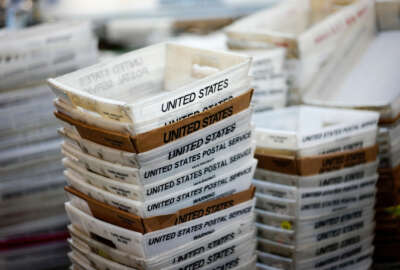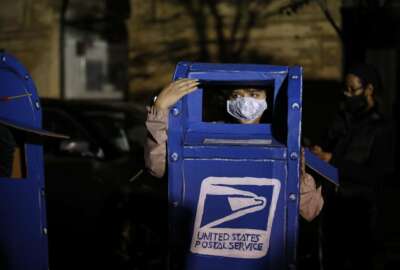

One historian just authored a book that tells us how the Postal Service enabled the settling of the West in a historically short time. Author Cameron Blevins...
Best listening experience is on Chrome, Firefox or Safari. Subscribe to Federal Drive’s daily audio interviews on Apple Podcasts or PodcastOne.
You might have thought, if you thought about it at all, that the expansion of the Postal Service in the 19th century followed the settling of the Western half of the United States. But one historian just authored a book that tells us that the Postal Service, in fact, enabled the settling of the West in a historically short time. The book is titled Paper Trails: The U.S. Post and the Making of the American West. The author is Cameron Blevins and he discussed his research on Federal Drive with Tom Temin.
Interview transcript:
Tom Temin: Mr. Blevins, good to have you on.
Cameron Blevins: Thanks so much for having me on. I appreciate it.
Tom Temin: And we should also point out that you teach history at the University of Colorado, Denver. How did you get interested in the Postal Service of all things.
Cameron Blevins: So I was fascinated with the history of the Western United States going into graduate school. And I was interested in specifically looking at the geography of how and where people moved. And I was doing a research paper and decided to use post offices as a way of measuring that movement, the idea being if you could figure out where post office was located, you can then figure out where people were living and moving to. But I realized pretty quickly after starting to look at the archives, and look into this project, that in fact, the US postal system was not just some kind of proxy for settlement, but in many ways enabled and accelerated all sorts of expansion in the West. And so that was the entry point for me.
Tom Temin: And the Postal Service, as it was known then was very different. It was in homes, it was in barns, it was in country stores, and so forth. Is your thesis in the book that the Postal Service almost went with the people trying to expand into the western part of the country and set up shop as they did?
Cameron Blevins: Correct. I mean, it’s, for me, at least coming into it, I had a vision of what the US postal system is, but it’s very much late 20th century-21st century where the standalone building, there are salaried federal employees wearing uniforms standing behind the counter. And that’s just not the case across the vast majority of the country in the 1800s. So your local post office would not be the post office we think of today, it would be your store owner giving out letters occasionally for a very small annual commission from the federal government. And the mail will be carried not in these official USPS vehicles, but contracted with private stagecoach companies to toss a bag or two of mail in the back of their stagecoach alongside passengers. And so trying to understand how this system operated, was a really fascinating part for me. And what I ended up realizing was that because of these arrangements, these kind of public-private partnership arrangements, the US post was able to expand really, really quickly into pretty distant and remote areas of the country, especially in the Western United States. And so if you had a mining strike, let’s say in Idaho territory, within a matter of weeks or months, the US mail would begin to arrive there because a local store owner would be able to distribute mail, and a stagecoach company could transport it. And there are all sorts of other implications that came along with this that I can get into. But that was the basic framework for how the US postal system expanded in the West.
Tom Temin: For the most part, you really couldn’t have an established settlement then without the Postal Service, because it was way before telephone lines, even before telegraph. And certainly before everything else we understand as communications nowadays.
Cameron Blevins: Certainly. I think a big misconception is that even after the telegraph started to expand, if you look at mass, large majority the country you do not have access to a telegraph system. And even if you do, it’s phenomenally expensive. It is a private communications network, and was actually termed the rich man’s mail. So for most people, you would not be able to afford to use the telegraph reliably. And certainly news could transmit over the telegraph. But ultimately, that last mile was conducted via letters, newspapers being delivered to post offices. So the US post was the most democratic institution in terms of communication networks – accessibility, affordability for 19th century Americans. And that’s especially true again, in these really distant remote areas where they were so dependent on the mail as their lifeline essentially to the rest of the country.
Tom Temin: We’re speaking with Cameron Blevins, he’s author of Paper Trails: The US Post and the Making of the American West, also a professor of history at the University of Colorado. Just give us some of the statistics for how many postal locations there were back then.
Cameron Blevins: It’s pretty staggering. This was something that surprised me. At the end of the 1800s, so about 1899, there were about two and a half times as many post offices as there are today. And there were also if you start compare it to, let’s say private institutions today, I don’t know the exact figures, but it’s something like if you total up every single McDonald’s, Starbucks, Burger King, Taco Bell, eight of the largest fast food companies, pull them all together, it would still be fewer locations than there were post offices at the end of the 1800s. And so this massive, massive system was far larger and more expansive than any other postal system in the world by several factors. So it was this kind of giant almost hiding in plain sight. But again, because of the way it operated, because of the way it was connected to your local store owner, a stagecoach company, it didn’t seem as large as those numbers might appear. But it does mean that it was really central to people’s lives.
Tom Temin: And you mentioned some of the other effects of having this earlier, what were some of those?
Cameron Blevins: If you are moving to a distant part of the country, if you’re trying to start, let’s say, a ranch in Arizona, you are dependent on the mail for pretty much any contact with the outside world. So I followed this story of these four orphans, one of whom ends up doing exactly that, moving to the backwoods of Arizona to start a ranch, and he’s living in the middle of nowhere. He is 30 to 40 miles away from the nearest major town with a doctor or newspaper. But despite that, if you look at his letters, he’s completely connected to the outside world, he is subscribing to half a dozen newspapers and magazines from Chicago and San Francisco, in New York, he’s communicating with his sisters who live in San Diego, and he’s getting mail from them within five or six days. And in fact, he has two post offices within about a 20 minute walk from his house. And so this is the kind of effect that I think the post had, it’s not necessarily causing all of these people to move to these really remote inhospitable places — but it’s really accelerating that process and allowing them to do so much more easily than they would have otherwise.
Tom Temin: And the population of the West grew very rapidly. That is, I think you point out that in one generation, it was populated all over, a process that had taken several generations in the East.
Cameron Blevins: Correct. And the post plays a big part of that. And this is roughly speaking, the 1840s, through the 1890s, this huge transformation of the Western United States. And the central piece of that was not that the West was not populated before that, it was that it was populated by Native people. And the federal government over the span of a couple of decades really waged war against Western tribes, wars of extermination, and then removal. And so the military is playing this really important role in terms of conquest and violence. But then the US post is kind of the civilian infrastructure that comes right on its heels to then allow white settlers to take over and occupy what is effectively stolen land. And that’s that speed of that process unfolding, again, in a span of one generation, it’s kind of staggering to think about.
Tom Temin: And you also follow the change or transmogrification, of the Postal Service from that huge network of tiny locations, to maybe not what it is today, because that’s a creature of the 1970s. But between, say, 1890, and the middle of the 20th century, something changed.
Cameron Blevins: So there’s a couple different landmarks. But I would say one of the most important in terms of the shape and the function of the network is rural free delivery was first instituted in the 1890s on an experimental basis. And the idea was that prior to this, if you did not live in a big city, you had to go to your local post office to send or receive mail. But with rural free delivery, which then gets instituted officially in 1902, and then spreads from there over the next one to two decades, that changes. The mail is suddenly being delivered to, again, the doorsteps of Americans just regardless of where you live. And that causes the closure of tens of thousands post offices, this kind of consolidation of the network because people don’t need to have a post office within a couple miles of where they live. And with that you start to see a shift away from this system of relying on the local store owner getting paid 80 bucks a year to hand out letters to more of these salaried employees. And it’s not a full transformation, right, even today and through the 20th century obviously, we still have this contract system to transport mail over highways, for instance. And what’s fascinating to me, actually, is that you’re starting to see a resurgence of some of these older model. Village post offices, for instance, in the last 10 years or so, where the US post is starting to experiment with ways of serving particular rural communities with a model that looks a lot more like the 1800s than the kind of 1900s model of these kind of salaried, full time employees.
Tom Temin: I guess past is prologue in more ways than one. Cameron Blevins is author of Paper Trails: The US West and the Making of the American West. He’s also a professor of history at the University of Colorado. Thanks so much for joining me.
Cameron Blevins: Thank you so much for having me. It’s really great to talk to you.
Copyright © 2024 Federal News Network. All rights reserved. This website is not intended for users located within the European Economic Area.
Tom Temin is host of the Federal Drive and has been providing insight on federal technology and management issues for more than 30 years.
Follow @tteminWFED



